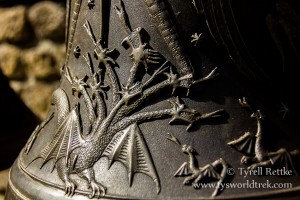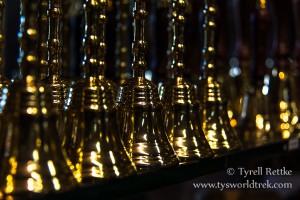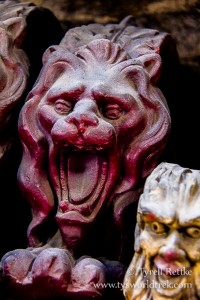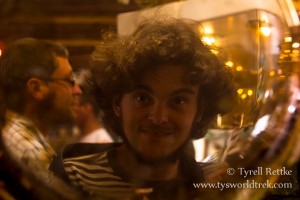The town of Villdieu Poeles in the Normandy region of France has been a center of copper and metal works for many years. It is home to one of only 2 operating bell foundries in all of France, and the larger of the two. I had the pleasure of visiting recently and taking a tour of the age old work shop.
 A bell is first and foremost a musical instrument. Each bell has a specific note that it rings at. The size and mass of the bell determines this note, and the material it’s made of determines the quality of the sound. The process that this foundry uses to create it’s bells, whether a massive bell used in a church tower that can weigh 8 tons, or a small one that weighs only a few pounds, is called lost wax casting. Essentially a wax version of the full sized bell is formed, sandwiched between a mold. This mold is made of clay mixed with horse manure and straw, a mixture that can withstand the heat of the molten metal. After the wax is melted away, a void is left for the metal to flow into. After the pour is complete the bell is allowed to cool while buried in sand to both support the now very heavy bell and to allow the metal to cool slowly enough that the new bell doesn’t crack.
A bell is first and foremost a musical instrument. Each bell has a specific note that it rings at. The size and mass of the bell determines this note, and the material it’s made of determines the quality of the sound. The process that this foundry uses to create it’s bells, whether a massive bell used in a church tower that can weigh 8 tons, or a small one that weighs only a few pounds, is called lost wax casting. Essentially a wax version of the full sized bell is formed, sandwiched between a mold. This mold is made of clay mixed with horse manure and straw, a mixture that can withstand the heat of the molten metal. After the wax is melted away, a void is left for the metal to flow into. After the pour is complete the bell is allowed to cool while buried in sand to both support the now very heavy bell and to allow the metal to cool slowly enough that the new bell doesn’t crack.
After a rough polishing, the bell is tuned, with metal being shaved away from the interior to get precisely the required note ordered. Next a fine polishing is performed and the bell is complete.
 The artistry that goes into making the decorations that adorn the bells is incredible. Most of the various adornments that are used on bells start out as a drawing. From these drawings, a 3D wax version is created. From this a mold is made, of silicone. In times past a wooden mold would have been carved. With a mold, the artists can make exact duplicates of these artistic flourishes and attach them to the main wax body of the wax casting.
The artistry that goes into making the decorations that adorn the bells is incredible. Most of the various adornments that are used on bells start out as a drawing. From these drawings, a 3D wax version is created. From this a mold is made, of silicone. In times past a wooden mold would have been carved. With a mold, the artists can make exact duplicates of these artistic flourishes and attach them to the main wax body of the wax casting.
The Villedieu Poeles foundry tour is quite informative, and the guides are all very friendly. I enjoyed taking a few of the french kids I was helping out with on the tour, getting the chance to see, hear and even feel the process of bell making in a real operating foundry. This very foundry had just last year recreated the 8 giant bells that are now hanging in Notre Dame in Paris, returning the musicality of the cathedral after many years of absence. Using detailed accounts and descriptions of the bells, they were able to recreate the notes that would have originally played out when played hundreds of years ago.
 The small gift shop had many copper offerings, including hand made items and machine rolled items, bells and beautifully craft items of various shapes and sizes. One last picture I snapped was a self portrait in the reflection of a large copper skillet. I hope you’ve enjoyed my story of a visit to a bell foundry. Please be sure to check out my pictures HERE and to “like” my facebook page HERE.
The small gift shop had many copper offerings, including hand made items and machine rolled items, bells and beautifully craft items of various shapes and sizes. One last picture I snapped was a self portrait in the reflection of a large copper skillet. I hope you’ve enjoyed my story of a visit to a bell foundry. Please be sure to check out my pictures HERE and to “like” my facebook page HERE.
